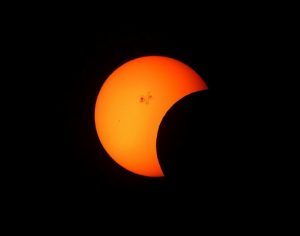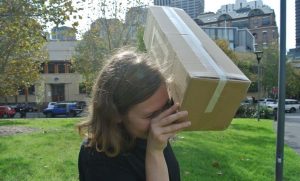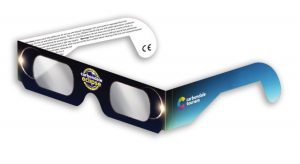Countdown to the Great American Eclipse is on across Illinois
Chronicle Media — August 17, 2017The Great American Eclipse will soon be creating awe and wonder in Illinois skies.
At first a solar eclipse appears slow, as just a small part of the Sun is blocked by the Moon. You won’t be able to tell anything is happening unless you look at the Sun.
A telescope won’t be needed, but you will need protective eyewear. (See below)
If you do look at the Sun, the process will start at 11:53 AM on Monday, Aug. 21.
As you watch the Sun, it becomes more and more obscured by the Moon, and you will begin to notice differences in your surroundings.

When the Sun is a little more than half covered, the color of the sky will slowly become a duller shade of blue
When the Sun is a little more than half covered, the color of the sky will slowly become a duller shade of blue. Shadows on the ground will appear sharper as the apparent size of the Sun shrinks, according to the University of Illinois.
Shadows in trees will begin to look odd and there will be many crescent shapes in the shadows, according to the University of Illinois scientists.
The tiny gaps in the leaves will act like multiple pinhole cameras, projecting the Sun’s image to the ground. When an eclipse is not happening, they are there too, as circles, but these don’t catch our attention since they blend together.
Very slowly, almost imperceptibly, as the eclipse moves toward totality, the western sky will become a little darker than the eastern sky (the shadow is approaching!), and slowly the colors of the landscape become more muted and gray-ish.
The sun will become a smaller and smaller crescent, but is still very bright. (Viewers will need eye protection up until totality.) When there is about 5 minutes until totality, the western sky becomes darker and darker, beginning to shroud the sun in darkness.

Using a pinhole projection method is the preferred method for viewing the total solar eclipse on Aug. 21 (Photo courtesy of Southern Illinois Eclipse)
Attending large events and viewing parties of the Aug. 21 event can be fun and exciting but you must ensure that you are taking safety precautions.
The eclipse will draw thousands of people to Southern Illinois, the epicenter of the path across Illinois, but there will be viewing parties in communities across the entire state.
Just like any event of this magnitude, many areas can become crowded. Below is a list of things to keep in mind to ensure you and your families safety.
- Do not bring your personal valuables.
- Be aware of your surroundings. Know where you’re going and who’s around you.
- Bring allergy and any required medication with a first aid kit. Being in a new environment can often trigger the unknown.
- Sunscreen and bug spray are your friends. Be sure to reapply as needed and/or required.
- Stay hydrated but don’t leave your drink unattended. Even soft drinks can be spiked.
- Be conscious of your clothing to avoid heat exhaustion, layers can help cool you when needed.
- Bring a portable charger to ensure your mobile is charged on a daily basis.
- Follow well-lit paths at night. Do not venture into darker, quieter areas, you can explore in the daylight.
- Organize a meeting point with your friends and family of where you will be three times a day (e.g. 2 p.m., 6 p.m. and 1 a.m.) in case you get split up.
- Bring only the cash and cards you need. Make a note of your bank’s emergency number to call if your cards are stolen. If going to Southern Illinois region, it is important to note that not all nationally recognized banks are located in that area.
- Report any incident, even near misses, as soon as possible. You may save someone else.

Having special glasses to view the eclipse will protect your eyes. (Photo courtesy of Southern Illinois Eclipse)
The most important aspect of the total solar eclipse is viewing it. The sun emits ultraviolet (UV) radiation which can harmfully damage your eyes without proper protection. To avoid ultimately going blind take the following special precautions.
DO:
- Wear eclipse glasses
- Use a welder’s glass with a grade of 14
- Use a pinhole projection method (To learn how to make one, go to http://eclipse.illinois.edu/pinhole.html)
- Solar telescopic viewing
DON’T:
- Wear sunglasses for viewing
- Wear Eclipse Glasses to view through an unfiltered telescope
If you’re planning on observing the 2017 solar eclipse, stay safe with these eclipse viewing tips from NASA.
To find out eclipse schedule, go to http://southernillinoiseclipse.com/the-eclipse/eclipse-predictions-in-il.
—— Countdown to the Great America Eclipse is on across Illinois —






